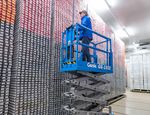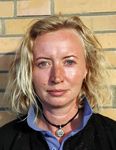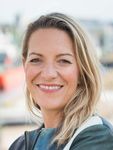The ocean in depth! - MARUM
←
→
Page content transcription
If your browser does not render page correctly, please read the page content below
The ocean in depth!
MARUM Newsletter January 2019
Dear Reader,
With the new Cluster of Excellence we
face the opportunity of opening a new
chapter in ocean-floor research (see
adjacent article). Beyond the ambitious
scientific goals of the Cluster, we are
also pursuing a series of structural
objectives. These include our plan to
fill half of the scientist positions in the
Cluster with women. The academic job
market is constantly changing, which
presents complex challenges for a
university institution such as MARUM
in the attraction and training of young
talent for that market. For young scien-
tists embarking on their new careers,
we are continuing our well-established
doctoral program. Through a new pro-
gram we will provide support for post-
[ Research ] docs in the important phase after their
Cluster of Excellence Ocean Floor
PhD work is completed. In addition to
training, we will take advantage of the
possibilities of the Cluster to further
At MARUM – Center for Marine Environ- occur in the ecosystem, it will presumably
develop secure career paths in science,
mental Sciences at the University of Bre- take decades to recover. Investigations at
for example, through tenure-track
men, a new Cluster of Excellence is being MARUM, therefore, will continue to focus
positions. In the coming year, in our
launched in 2019. With the proposal “The on how the sensitive ecosystems of the
role as a university employer, we want
Ocean Floor – Earth’s Uncharted Interface”, deep sea react to a changing environment,
to help create trend-setting models
the scientific goals of the group successfully including rising temperatures.
for improved balancing of families and
reflected the Excellence Strategy of the The seafloor is also a unique archive that
careers.
German Federal and State Governments. records the environmental conditions of the
The researchers will fully concentrate their past within its sediments.
efforts on this still uncharted interface of An exceptional fleet of equipment opera- I wish you a very enjoyable read,
the Earth. ted by MARUM is deployed for research,
The ocean floor plays an important role, for including submersible robots, drilling rigs
example, in the global carbon cycle as well and autonomous underwater vehicles.
Michael Schulz (Direktor)
as the climate system in general. Geolo- The new scientific challenges are being
gical, physical, chemical and biological tackled not only by the development of
processes interact with one another at and new technologies, but also through new
within the ocean floor. analytical methods and models. The efforts
Researchers furthermore need to improve of scientists in the Cluster are enhanced by
our understanding of the specific processes close interdisciplinary projects with other
related to the transport of organic material. institutions in the region.
The same is true for carbon and other The Cluster of Excellence is based at the
elements – what happens when particles University of Bremen under the auspices
dissolve in seawater or are released from of the MARUM Research Faculty. The new
the seafloor into the water column? Cluster has its foundations in the previous
For approximately the past four decades, Research Center of the German Research
it has been well known that the deep sea Council and the Cluster of Excellence “The
Processes at the ocean floor are the center of
is not a desert, but rather an oasis of life, Ocean in the Earth System”.
focus in the new Cluster of Excellence.
albeit a very sensitive one. When changes www.marum.de/The-Ocean-Floor.html[ Research ]
ERC Starting Grant for research on sea-level changes
Marine researcher Alessio Rovere has ject. With a total of around 1.5 million Euros, about 128,000 and 116,000 years ago,
received an ERC Starting Grant from the Rovere’s work will be funded for a period of is often used for comparison to present
European Research Council. “WARMCOASTS five years beginning in 2019. conditions.
– sea level and extreme waves in the last In the field of climate research, the last This was the last time in the Earth’s history
interglacial” is the title of his research pro- interglacial period, which occurred between that the climate was warmer than in pre
industrial times. Both sea level and tempe-
ratures were higher than today, and the ice
sheets were smaller.
How will temperatures, sea level, and the
size of ice sheets change in the future?
Scientists believe that the answers lie in
understanding the processes during the
last interglacial.
“In this project we want to use a variety
of multidisciplinary methods to study sea
level, its fluctuations, and extreme waves
during the last interglacial,” explains
Alessio Rovere. He wants to apply the
grant money toward recruiting outstan-
ding young scientists to create a reliable
global database for sea level during the
last interglacial, and to study new field
areas with advanced modelling and measu-
rement technology.
“The results of this project,” Rovere is confi-
dent, “will contribute to a better understan-
ding of coastal processes under somewhat
warmer climate conditions.”
Alessio Rovere carrying out fieldwork with his colleagues. Photo: Elisa Casella
www.marum.de/en/Dr.-alessio-rovere.html
[ Technologies ] [ Expeditions ] [ Research ]
Successful tests Deep-sea observatories New joint research project
Ship time is limited and, above all, expen- Yann Marcon and Ulli Spiesecke have Since the summer of 2018, a joint research
sive. For this reason, chief scientists are installed two echo-sounder systems at project coordinated through MARUM has
very careful in assembling their expedition an underwater observatory of the Ocean been investigating how human and clima-
teams. A test has now been successfully Observatories Initiative (OOI) at a water te-change factors impact the ecosystems
carried out on the Research Vessel Sonne depth of 800 meters on the continental of South Africa. These include land-use
to evaluate a way in which the expertise margin off Oregon in the northeast Pacific. changes as well as pollution by industry
of onshore researchers can be integrated These sonar systems were developed at and agriculture. The consequences often
into onboard research via telepresence. This MARUM. They will enable researchers, in include soil erosion, eutrophication of wa-
concept was proposed by Volker Ratmeyer real time and over a period of several years, ters, and pollution input that have negative
and Hauke Büttner (both of MARUM) along to monitor and quantify the natural release impacts on the local biodiversity. To use
with Tom Kwasnitschka (GEOMAR). For this of methane from the seafloor in one of the natural resources sustainably, a detailed
purpose, a satellite communications system most active methane-seep areas known. and data-supported understanding is
was installed on the Sonne and tested Mounted on large titanium stands, the ins- important. This is necessary, says project
in the South Pacific. While the remotely truments were transported to the seafloor coordinator Matthias Zabel of MARUM, in
operated vehicle MARUM-Quest works in by a submersible robot and coupled to the order to assess the relationships between
the deep sea its every movement can be connecting socket of the deep-sea cable of after-effects, climate changes, and regional-
followed, not only by the scientists in the the OOI observatory. ly variable anthropogenic factors.
shipboard control container but also by The German-South African joint research
their colleagues on land. It is also possible project TRACES (Tracing Human and Cli-
for the land-based scientists to communi- mate impacts in South Africa) is financed
cate with the team on board in real time through 2021 by the Federal Ministry of
via audio signal. For the future, the concept Education and Research (BMBF). The part-
envisages that researchers who cannot ners comprise researchers at the Univer-
directly participate in the expedition can sities of Jena, Greifswald and Bremen, the
be fully integrated as team members. In South African universities in Durban/Pie-
addition to following the dives of remotely termaritzburg and Johannesburg, and the
Submersible robot Jason connects instru-
operated vehicles, the live transmission can South African Council for Geoscience.
ments to the cable-connection frame of the
also be used with autonomous underwater www.marum.de/en/about-us/Sediment-
observatory. Photo: NSF, OOI, UW, ROV Jason
vehicles and seafloor observatories. Geochemistry/Traces.html
Page 2 MARUM-Newsletter „The ocean in depth!“ January 2019[ MARUM visual ]
Soft coral
A soft coral with a whip-like growth form,
taken during a dive of the MARUM-Quest
in 1,929 meters water depth southwest of
Samoa.
Photo: ROV MARUM-Quest, Expedition SO263, RV Sonne
[ Research ] and in-situ measurements on the seafloor.
New research building at MARUM
The new, more capable ROV will dive to a
depth of up to 5,000 meters. Completion
of the new building is planned for the end
MARUM is acquiring a new research part of the MARUM Research Faculty. When
of 2022, and it will comprise around 4,000
building – the construction of the “Center the building is completed it will become
square meters for the equipment hall, core
for Deep Sea Research” (ZfT – Zentrum für home to a new cable-controlled submersib-
repository, laboratories and offices.
Tiefseeforschung) is scheduled to begin le robot (remotely operated vehicle – ROV).
in 2020. In the future, expertise for a new For the past 20 years researchers at MAR-
research field will be pooled here. The areas UM and from other institutes have been
of study will include, for example, the com- working with the MARUM-Quest. ROVs
plexes “Climate information from the deep have been used in deep-sea research by
sea”, “Extreme habitats in the deep sea” default for about 15 years, and during this
and “Triggers of natural hazards”. “With time they have contributed significantly
the ZfT, the existing comprehensive and to completely new discoveries. With their
internationally oriented profile of marine help, researchers on marine expeditions are
sciences in the state of Bremen will be rai- able to take samples with high precision
sed to a new level,” says MARUM Director and obtain high-resolution images. Additi- The Center for Deep-Sea Research (ZfT) will
Michael Schulz. The new building will be a onally, ROVs are deployed for experiments be located north of the MARUM building.
[ IODP ] cores will continue to grow in the future. sity (USA). This changed in 2003 with the
25-year anniversary of the The core repository was established in 1994, creation of the European Consortium for
originally in warehouse number 3 of what Ocean Research Drilling (ECORD). This was
Bremen Core Repository is now the Überseestadt harbor area, and preceded by the so-called Core Redistribu-
Not only does the new building provide at that time it was more or less a branch of tion Project, in which each of the three core
more room for technological equipment the core repository at Texas A&M Univer- repositories in Germany, the USA and Japan
and laboratories, it will also allow for the was assigned a region of the world‘s oceans
expansion of the IODP Bremen Core Repo- from which the cores are archived either
sitory (BCR). For almost 25 years, cores have in Bremen, College Station or Kochi. But
been stored here from the Atlantic and MARUM provides more than just a storage
Arctic Oceans as well as the Mediterranean, area for the cores. The repository, especially
Black and Baltic Seas that were drilled by since its move to the university campus,
the International Ocean Discovery Program also incorporates an infrastructure for
(IODP) and its forerunner programs begin- researchers, with diverse laboratories and
ning in 1968. The collection comprises over analytical opportunities. Scientists from
a quarter million core sections, which, laid around the world come to take samples for
end-to-end, would total a length greater themselves, or they may have the BCR staff
than 155 kilometers. It is the largest of the 155 kilometers of cores are archived in the take and send them samples. The number
three IODP core repositories, and with the IODP Bremen Core Repository. of samples provided over the past quarter
current expedition plans the number of century totals over one million.
MARUM-Newsletter „The ocean in depth!“ January 2019 Page 3[ IODP ] [ Technologies ]
NanTroSEIZE: Targeting a plate boundary Cooperation with Google
What happens when one tectonic plate the causes of earthquakes, and to collect The information system PANGAEA, which is
slides underneath another? This question data on how water and rocks react with one operated by MARUM and the Alfred Wege-
is the focus of IODP Expedition 358. This is another at a subduction zone to possibly ner Institute Helmholtz Centre for Polar and
the ultimate phase of the Nankai Trough trigger earthquakes. Fifteen expeditions Marine Research (AWI), is cooperating with
Seismogenic Zone Experiment (NanTroSEI- have been carried out since 2007; 68 holes Google and other data centers in the de-
ZE), in which the researchers want to drill with a total length of 34 kilometers have velopment of a prototype. In order to make
into the fault zone. The target of the cruise been drilled into the seafloor; and observa- research data accessible around the world,
is the plate boundary at a depth of about tories have been installed. It is the longest the company has established the “Google
5,000 meters below the seafloor. Matt Ikari expedition in the history of the Interna- Dataset Search”. Users can search the inter-
from MARUM takes part in the project. As tional Ocean Discovery Program (IODP). net for datasets, regardless of where they
a specialist for plate tectonics, he is one of Instead of the usual eight weeks for IODP are stored and published. This is currently
the project’s chief scientists. Expeditions to cruises, alternating teams will be working available for data in the environmental and
the Nankai trough have been carried out on the Japanese drilling ship Chikyu from social sciences.
over the past eleven years to investigate October 2018 to March 2019. https://toolbox.google.com/datasetsearch
[ Research ]
[ Personnel ] for their dissertations. The prize is awarded
Polarstern Expedition
Two awards annually for outstanding scientific theses in
Hydrothermal vents and possibly cold seeps the field of marine sciences at the Universi-
at the Sandwich microplate in the Southern In 2018, Prof. Dr. Antje ty of Bremen. Maren Elisabeth Richter and
Ocean are the targets of Expedition PS Boetius was awarded Lucy Schlicht were awarded for their master
119 of the research vessel Polarstern. both the Communicator theses
The cruise begins in April. Its goals are to Award of the Deutsche
investigate fluid released from the seafloor Forschungsgemeinschaft
[ Personnel ]
and to study the accompanying biological (DFG) and the German
communities. It will be the first deployment Environmental Award. The New Directorate
of a submersible vehicle from the research German Federal Environmental Foundation
MARUM has a new Board of Directors. Prof.
vessel Polarstern in the Antarctic region. (Deutsche Bundesstiftung Umwelt – DBU)
Michael Schulz is Director and Professors
honors Antje Boetius for her achievements
www.marum.de/en/Research/PS119.html Monika Rhein and Achim Kopf have been
in deep sea and polar research, which have
Deputy Directors since 1 November. They
contributed significantly to our under-
will head the MARUM Research Faculty for
Dates and Events standing of global climate and biodiversity.
the next six years.
The Communicator Prize serves to strengt-
Ocean Day
hen the dialog between science and the
13 Feb 2019 University of Bremen
public.
www.marum.de/en/Discover/Ocean-Day.html
Symposium “25 years with the IODP core [ Personnel ]
repository”
Professorship in In Memoriam
12 Mar 2019 Haus der Wissenschaft,
Bremen Norway We mourn our depar-
ted colleague and a
Hanseatic City of Bremen Senate Reception Dr. Irina Roghozina has wonderful person, Dr.
in honor of the 75th birthday of Prof. Dr. moved from MARUM to Heiko Sahling. He had
Gerold Wefer the Norwegian University to leave us on April 23,
12 Mar 2019 City Hall, Bremen of Science and Techno- 2018 at the age of only
logy. There she has been 49 after a serious illness.
Professor of Physical Geography since Heiko worked for 15 years in the Depart-
August. Her main focus now is on climate ment of Geosciences and at MARUM, where
About us change-related natural hazards, impacts he helped to establish the working group
Editor of warming climate on ecosystems, both “General Geology / Marine Geology”. Heiko
Prof. Dr. Michael Schulz in the ocean and on land. In addition, her will remain in our memories as a friendly,
MARUM – goal is to develop an educational program thoughtful, reliable, dear and creative
Center for Marine Environmental Sciences for schools and the general public that colleague. Scientifically, the deep sea with
University of Bremen combines the results of climate research all its facets appealed to him. He participa-
Leobener Straße 8, D-28359 Bremen with new technologies and media such as ted in expeditions with great enthusiasm,
Germany virtual reality. as well as designing and leading them.
His scientific work on board was always
Compilation, Composition, and Photos [ Personnel ] followed up by meticulous processing of
the data and significant contributions that
MARUM
Printer
MARUM Research Award he incorporated into the broader scientific
Universitätsdruckerei Bremen The “MARUM Research Award for Marine framework. He was always helpful and
Sciences 2018” is awarded to Dr. Kerstin good-humored, and played an essential role
www.marum.de Kretschmer and Dr. Clara Martínez-Pérez in the working group.
Page 4 MARUM-Newsletter „The ocean in depth!“ January 2019You can also read



























































